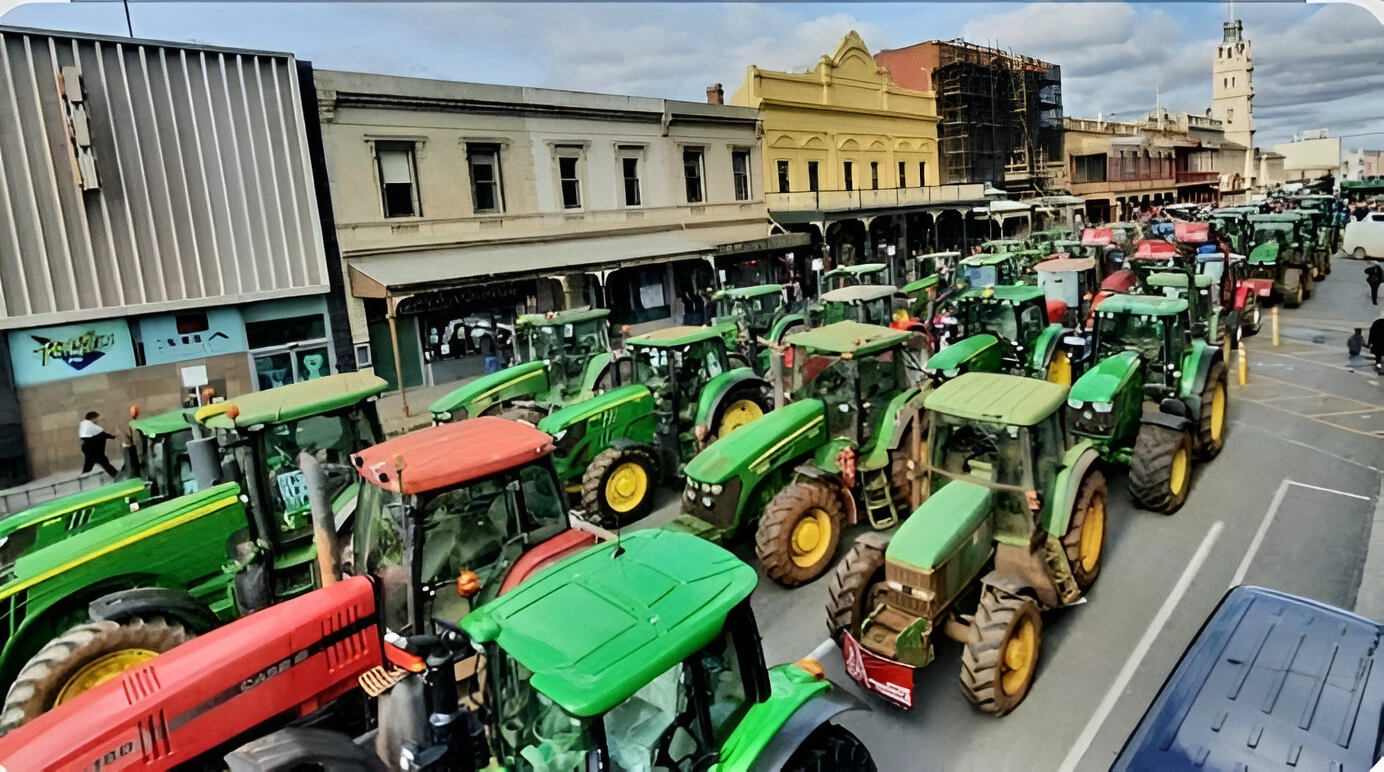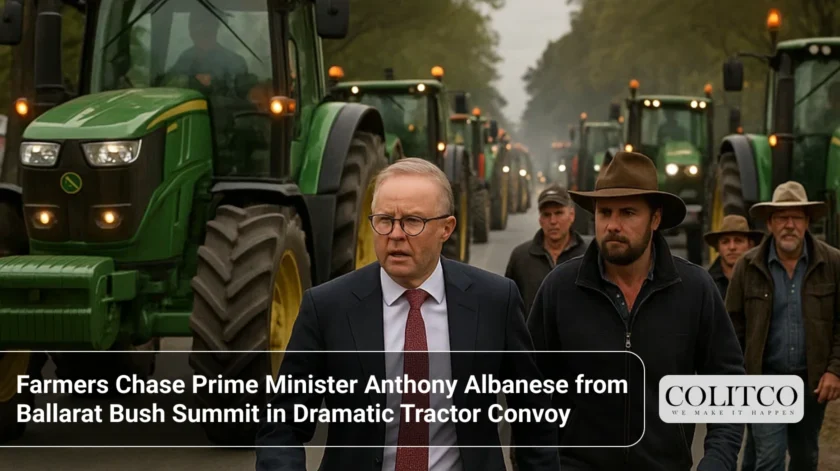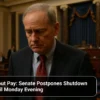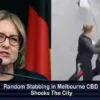Prime Minister Anthony Albanese experienced an unprecedented reception at the Ballarat Bush Summit on 29th August 2025, when his motorcade was pursued through the Victorian city streets by angry farmers driving tractors. The dramatic scenes unfolded as hundreds of agricultural producers descended on Civic Hall to voice their fury over the state government’s new Emergency Services and Volunteers Fund and controversial transmission line projects.
Footage captured by local media showed Albanese’s white motorcade being followed closely by fast-moving tractors as his security detail navigated through Ballarat’s CBD. The extraordinary protest represents one of the most visible demonstrations of rural discontent with current government policies affecting farming communities across Victoria.
“Dramatic scenes in Ballarat as Prime Minister Anthony Albanese’s motorcade is chased by a convoy of angry farmers in their tractors.” – Herald Sun 🚗 💨 🚜 💨 pic.twitter.com/l8hhD77FcL
— Joel Jammal (@JoelJammal) August 29, 2025
Bush Summit Becomes Flashpoint for Rural Anger
The Herald Sun Bush Summit, which featured Prime Minister Anthony Albanese as the keynote speaker alongside Opposition Leader Sussan Ley and Victorian Premier Jacinta Allan, was intended to address rural-urban infrastructure divides. Instead, it became a lightning rod for farmer frustrations that have been building for months.
Numerous CFA vehicles, tractors and cars circled the block around the Mair Street venue, making themselves known with sirens, horns and theatrical displays of protest. The demonstration involved multiple stakeholder groups, from emergency service volunteers to climate activists, each bringing distinct grievances to the political gathering.
Country Fire Authority trucks joined the slow-moving convoy around Civic Hall, while Nationals Senator Bridget McKenzie arrived on a tractor holding a sign reading ‘Stop Labor’s Towers’. The visual spectacle highlighted the depth of rural opposition to current policy directions.
Emergency Services Levy Sparks Farmer Outrage
Central to the protests was Victoria’s controversial Emergency Services and Volunteers Fund (ESVF), which replaced the Fire Services Property Levy from 1st July 2025. The new levy is projected to more than double from approximately $2.7 million to over $5.5 million in affected councils, with primary producers shouldering 88% of the total increase.
Individual farmers face staggering cost increases under the new regime. One local farmer and active emergency services volunteer saw their levy jump from approximately $14,761 to almost $40,000 annually. Even with volunteer exemptions offering maximum savings of $4,150, the financial burden remains substantial.

Farmers’ Tractor Rally Protest at the Bush Summit
Vernon Dawson, a Skipton CFA volunteer with 40 years of service, described the levy as “crippling”. He told reporters his emergency services payments increased from $3,000 two years ago to $10,000 last year, with projections reaching $30,000 within two years.
The levy expansion funds additional emergency services including VICSES, Triple Zero Victoria, State Control Centre, and Forest Fire Management Victoria. However, rural communities argue they’re unfairly bearing the cost burden for metropolitan services.
Transmission Line Projects Fuel Additional Discontent
Farmers also protested against renewable energy transmission projects cutting through their properties. The recently passed VicGrid Bill grants state authorities powers to access private farmland using “reasonable force” to build transmission towers, with penalties of several thousand dollars for those who obstruct access.
Murrabit sheep and cattle farmer Linda Coote, whose property will host VNI West transmission lines, called the legislation “absolutely disgraceful”. The transmission infrastructure is part of Victoria’s broader renewable energy transition, but rural landowners feel their concerns have been dismissed.
James Plush, a local farmer attending the protests, refused to enter the summit venue, stating: “I don’t really want to hear their untruths, would be my way of putting it.“
This tension reflects broader challenges in Australia’s energy transition, where rural communities often bear the infrastructure burden for renewable projects serving urban centres.
Premier Allan Blocked by Protesters
Victorian Premier Jacinta Allan faced even more intense opposition than the Prime Minister. After addressing the crowd inside Civic Hall, Allan was blocked by protesters as she tried to leave the event in her car, with angry CFA members and farmers parking tractors and firetrucks on Creswick Road.
Police were forced to scramble for an alternative exit route as the demonstration brought Ballarat’s CBD to a standstill. The premier’s experience highlighted the personal nature of rural anger toward state government policies.
About a dozen audience members stood and turned their backs on Allan during her presentation, while one woman held up a noose around her neck before being told to sit down by security. The hostile reception reflected deep-seated frustrations with state-level decision-making processes.
Victorian Premier Jacinta Allan at the Ballarat Bush Summit: …
Crowd member: “Nobody wants you here, go back behind the stage.” pic.twitter.com/9p0tfpmESc
— Australians vs. The Agenda (@ausvstheagenda) August 29, 2025
Government Response and Industry Context
During his speech, Prime Minister Anthony Albanese announced $1 billion in additional low-interest loans for drought and flood-affected farmers through the Regional Investment Corporation. However, the gesture appeared insufficient to calm protesters’ concerns about broader policy directions.
The tensions emerge as Australia’s mining sector calls for bold reforms to maintain global competitiveness. Mining executives have urged the Albanese government to redirect fossil fuel subsidies toward clean energy infrastructure, creating additional pressure points between traditional industries and renewable energy mandates.
The Bush Summit’s corporate sponsorship, including backing from Hancock Prospecting, drew criticism from environmental groups who accused organisers of industry capture. This highlighted the complex intersection of agricultural, mining, and environmental interests in contemporary Australian politics.
Financial Impact on Rural Communities
The Emergency Services and Volunteers Fund represents a significant shift in how Victoria funds emergency services, with rural ratepayers facing disproportionate increases. Variable rates for primary production properties jumped from 28.7% to 83% of capital improved value, even after the government’s 16% reduction for farmers.
Critical minerals development in rural areas adds another layer of complexity, as communities balance economic opportunities against infrastructure disruption. The intersection of renewable energy projects, emergency service funding, and agricultural productivity creates multiple pressure points for policy makers.
Rural Councils Victoria estimates the new levy will extract $139 million annually from rural communities, raising questions about equitable burden-sharing between metropolitan and regional areas.
Also Read: Tesla Enables Full Self-Driving in Australia
Final Thoughts
The extraordinary scenes at Ballarat demonstrate the growing disconnect between urban policy makers and rural communities bearing the costs of energy transition and service expansion. Prime Minister Anthony Albanese‘s tractor chase symbolises deeper tensions about who pays for Australia’s transformation toward renewable energy and expanded emergency services.
With similar protests spreading across Victoria and farmers threatening continued action, the government faces mounting pressure to address rural concerns about levy increases and transmission infrastructure. The Bush Summit’s dramatic conclusion suggests these issues will continue shaping political discourse as Australia navigates competing demands between climate action and rural sustainability.












